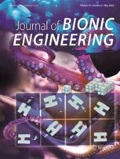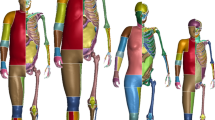Abstract
A subsystem impactor test for pedestrian lower limb injury evaluation has been brought in China New Car Assessment Protocol (CNCAP). Concerning large anthropometric differences of the people from different countries, the present study aims to establish and validate a finite element lower limb model representing 50th Chinese male size for pedestrian safety research, then compare its biomechanical responses with the general models currently in wide use in the world for pedestrian safety evaluation. Concerning the vehicle-pedestrian impact loading environment, the previously developed lower limb model with three-dimensional muscles was adjusted and validated through the related experiments. Then, the biomechanical responses of the validated model were compared with the Total Human Model for Safety (THUMS) and Advanced Pedestrian Legform Impactor (aPLI) models by combing with four typical vehicles. The results showed that both consistency and significant differences of biomechanical responses existed between the present model and the other two models. The injury measurements of the thigh region of the present model showed extremely large differences with the other two models, while the tibia and Medial Collateral Ligament (MCL) injury measurements show similar values. Thus, it can be concluded that directly using the aPLI or THUMS models for Chinese pedestrian safety evaluation is not robust concerning both kinematic responses and injury measurements.
Similar content being viewed by others
References
Li G B, Wang F, Otte D, Cai Z, Simms C. Have pedestrian subsystem tests improved passenger car front shape?. Accident Analysis and Prevention, 2018, 115, 143–150.
Li G B, Yang J K, Simms C. Safer passenger car front shapes for pedestrians: A computational approach to reduce overall pedestrian injury risk in realistic impact scenarios. Accident Analysis and Prevention, 2017, 100, 97–110.
World Health Organization. Global Status Report on Road Safety 2013: Supporting a Decade of Action, 2013. Available online: http://www.who.int/violence_injury_prevention/road_safety_status/2013/en.
Liu G D, Chen S Y, Zeng Z Q, Cui H J, Fang Y F, Gu D Q, Yin Z Y, Wang Z G. Risk factors for extremely serious road accidents: results from national road accident statistical annual report of China. PloS One, 2018, 13, e0201587.
China New Car Assessment Programme Management Regulation, China Automotive Technology and Research Center, 2018 version, 2018.
European New Car Assessment Programme (EuroNCAP), Pedestrian Testing Protocol, Version 8.4, 2017.
Japan New Car Assessment (JNCAP), Pedestrian Leg Protection Performance Test Procedure, 2018.
Isshiki T, Antona-Makoshi J, Konosu A, Takahashi Y. Consolidated technical specifications for the advanced pedestrian legform impactor (aPLI). Proceedings of the IRCOBI Conference, Athens, Greece, 2018.
Konosu A, Isshiki T, Takahashi Y. Development and evaluation of the advanced pedestrian legform impactor prototype which can be applicable to all types of vehicles regardless of bumper height-Part 1: Finite element model. Proceedings of the International Research Council on Biomechanics of Injury (IRCOBI) Conference, Zurich, Switzerland, 2016.
Guan T Q. Modeling and Application of a China 50 Percentile Pedestrian Lower Limb Finite Element Model. Master dissertation, Hunan University, 2019. (in Chinese)
Fubini E, Masali M, Giordano P. INTERNATIONAL STANDARD ISO/TR 7250-2: Basichuman body measurements for technological design Part 2: Statistical summaries of body measurements from national populations, 2010.
Mo F H, Arnoux P J, Cesari D, Masson C. Investigation of the injury threshold of knee ligaments by the parametric study of car-pedestrian impact conditions. Safety Science, 2014, 62, 58–67.
Mo F H, Masson C, Cesari D, Arnoux P J. Coupling lateral bending and shearing mechanisms to define knee injury criteria for pedestrian safety. Traffic Injury Prevention, 2013, 14, 378–386.
Mo F H, Arnoux P J, Jure J J, Masson C. Injury tolerance of tibia for the car-pedestrian impact. Accident Analysis and Prevention, 2012, 46, 18–25.
Matsui Y. Safety assessment characteristics of pedestrian legform impactors in vehicle-front impact tests. Accident Analysis and Prevention, 2014, 73, 65–72.
Masson C, Arnoux P J, Brunet C, Cesari D. Pedestrian injury mechanisms & criteria: A coupled experimental and finite element approach. Proceedings of the Experimental Safety Vehicles Conference, Washington, USA, 2005.
Beillas P, Begeman P C, Yang K H, King A I, Arnoux P J, Kang H S, Kayvantash K, Brunet C, Cavallero C, Prasad P. Lower limb: Advanced FE model and new experimental data. Stapp Car Crash Journal, 2001, 45, 469–494.
Scattina A, Mo F H, Masson C, Avalle M, Arnoux P J. Analysis of the influence of passenger vehicles front-end design on pedestrian lower extremity injuries by means of the LLMS model. Traffic Injury Prevention, 2018, 19, 535–541.
Kimpara H, Nakahira Y, Iwamoto M. Development and validation of THUMS version 5 with 1D muscle models for active and passive automotive safety research. Proceedings of the 38th Annual International Conference of the IEEE Engineering in Medicine and Biology Society, Orlando, USA, 2016.
Iwamoto M, Nakahira Y, Kimpara H. Development and validation of the Total Human Model for Safety (THUMS) toward further understanding of occupant injury mechanisms in precrash and during crash. Traffic Injury Prevention, 2015, 16, 36–48.
Untaroiu C D, Yue N, Shin J. A finite element model of the lower limb for simulating automotive impacts. Annals of Biomedical Engineering, 2013, 41, 513–526.
Untaroiu C, Darvish K, Crandall J, Deng B, Wang J T. Development and validation of a finite element model of the lower limb. ASME International Mechanical Engineering Congress and Exposition, Anaheim, USA, 2004, 47225, 53–62.
Combest J J. Current status and future plans of the GHBMC (Global Human Body Models Consortium). Proceedings of the 6th International Symposium: Human Modeling and Simulation in Automotive Engineering, Heidelberg, Germany, 2016.
Klug C, Ellway J. Pedestrian Human Model Certification. In: European New Car Assessment Programme, 2019.
Mo F H, Li F, Behr M, Xiao Z, Zhang G J, Du X P. A lower limb-pelvis finite element model with 3D active muscles. Annals of Biomedical Engineering, 2018, 46, 86–96.
Mo F H, Li J J, Dan M C, Liu T, Behr M. Implementation of controlling strategy in a biomechanical lower limb model with active muscles for coupling multibody dynamics and finite element analysis. Journal of Biomechanics, 2019, 91, 51–60.
Carter D, Hayes W. Bone compressive strength: The influence of density and strain rate. Science, 1976, 194, 1174–1176.
Al-Dirini R M, Reed M P, Hu J, Thewlis D. Development and validation of a high anatomical fidelity FE model for the buttock and thigh of a seated individual. Annals of Biomedical Engineering, 2016, 44, 2805–2816.
Mo F H, Li J J, Yang Z R, Zhou S Y, Behr M. In vivo measurement of plantar tissue characteristics and its indication for foot modeling. Annals of Biomedical Engineering, 2019, 47, 2356–2371.
Kerrigan J R, Drinkwater D C, Kam C Y, Murphy D B, Ivarsson B J, Crandall J R, Patrie J. Tolerance of the human leg and thigh in dynamic latero-medial bending. International Journal of Crashworthiness, 2004, 9, 607–623.
Society of Automotive Engineers (SAE), SAE J833 Human Physical Dimensions, 2003.
Eriksson L, Sundmark H, Zellmer H, Fograscher K, Drexl B, Slagmaat M V. Using the Objective Rating Method (ORM) as a quality assessment tool for physical tests, test methods, and mathematical models. Proceedings of the 21st ESV Conference, Stuttgart, Germany, 2009.
Gehre C, Gades H, Wernicke P. Objective rating of signals using test and simulation responses. Proceedings of the International Technical Conference on the Enhanced Safety of Vehicles, Stuttgart, Germany, 2009.
Yamada H, Evans F G. Strength of Biological Materials. Williams & Wilkins Comp, Baltimore, USA, 1970.
Asang E. Experimental biomechanics of the human leg. A basis for interpreting typical skiing injury mechanisms. The Orthopedic Clinics of North America, 1976, 7, 63–73.
Ehler E, Lösche H. Die menschliche tibia unter biegebelastung. Beitrage zur Orthopadie und Traumatologie, 1970, 17, 291–304.
Kerrigan J R, Bhalla K S, Madeley N J, Funk J R, Bose D, Crandall J R. Experiments for establishing pedestrian-impact lower limb injury criteria. SAE Technical Paper, 2003, 2003-01-0895.
Van Dommelen J, Ivarsson B, Minary M, Millington S, Raut M, Kerrigan J, Crandall J, Diduch D. Characterization of the rate-dependent mechanical properties and failure of human knee ligaments. SAE Technical Paper, 2005, 114, 80–90.
Maïsetti O, Hug F, Bouillard K, Nordez A. Characterization of passive elastic properties of the human medial gastrocnemius muscle belly using supersonic shear imaging. Journal of Biomechanics, 2012, 45, 978–984.
Mo F H, Zheng Z F, Zhang H T, Li G B, Yang Z R, Sun D Y. In vitro compressive properties of skeletal muscles and inverse finite element analysis: Comparison of human versus animals. Journal of Biomechanics, 2020, 109, 109916.
Ivarsson B, Kerrigan J, Lessley D, Drinkwater D, Kam C, Murphy D, Crandall J, Kent R. Dynamic response corridors of the human thigh and leg in non-midpoint three-point bending. SAE Transactions, 2005, 114, 193–204.
Bose D, Bhalla K, Rooij L, Millington S, Studley A, Crandall J. Response of the knee joint to the pedestrian impact loading environment. SAE Technical Papers, 2004, 2004-01-1608.
Kajzer J, Schroeder G, Ishikawa H, Matsui Y, Bosch U. Shearing and bending effects at the knee joint at high speed lateral loading. SAE Transactions, 1997, 106, 3682–3696.
Acknowledgment
This work is supported by the Foundation for Innovative Research Groups of the National Natural Science Foundation of China (Grant No. 51621004), National Natural Science Foundation of China (Grant No. 51875187), Hunan Youth Talent Program (Grant No. 2020RC3016), and Hunan Provincial Natural Science Foundation of China (Grant No. 2019JJ40021).
Author information
Authors and Affiliations
Corresponding author
Rights and permissions
About this article
Cite this article
Mo, F., Luo, D., Tan, Z. et al. A Human Active Lower Limb Model for Chinese Pedestrian Safety Evaluation. J Bionic Eng 18, 872–886 (2021). https://doi.org/10.1007/s42235-021-0067-2
Published:
Issue Date:
DOI: https://doi.org/10.1007/s42235-021-0067-2




